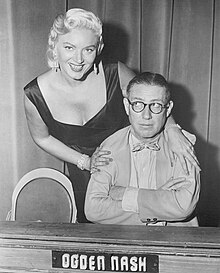Ogden Nash
| ||
 | ||
| Data i miejsce urodzenia | 19 sierpnia 1902 Rye, Nowy Jork, USA | |
| Data śmierci | 19 maja 1971 | |
| Zawód, zajęcie | poeta | |
Ogden Nash (ur. 19 sierpnia 1902 w Rye, zm. 19 maja 1971 w Baltimore) – amerykański poeta.
Wczesne lata
Był synem Mattie (z domu Chenault) i Edmunda Strudwicka Nasha[1][2]. Jego ojciec zajmował się importem i eksportem towarów i z powodu charakteru tej pracy cała rodzina często się przeprowadzała. Nazwa miasta Nashville została nadana na cześć jego przodka[2]
Po ukończeniu St. George's School w 1920 roku rozpoczął studia na Uniwersytecie Harvarda; naukę przerwał po roku[3]. Nash pracował w kilku zawodach, na ogól przez krótki czas, m.in. na Wall Street, w szkole, jako copywriter[2] czy w wydawnictwie Doubleday jako redaktor[3].
Twórczość
W 1931 roku wydał pierwszy tomik poezji Hard Lines, który przyniósł mu rozpoznawalność w Stanach Zjednoczonych[3].
W Polsce jego wiersze znane są z publikowanych w „Przekroju” tłumaczeń Ludwika Jerzego Kerna[4] oraz przekładów Stanisława Barańczaka, zamieszczonych w trzech antologiach: Fioletowa krowa: 333 najsławniejsze okazy angielskiej i amerykańskiej poezji niepoważnej od Williama Shakespeare'a do Johna Lennona (Poznań 1993; Kraków 2007); Od Chaucera do Larkina. 400 nieśmiertelnych wierszy 125 poetów anglojęzycznych z 8 stuleci (Kraków 1993); Od Walta Whitmana do Boba Dylana. Antologia poezji amerykańskiej (Kraków 1998). Barańczak przełożył także zbiór absurdalnych tekstów Ogdena Nasha pt. „W świecie mułów nie ma regułów” (Poznań 2007).
Życie prywatne
W 1934 przeprowadził się do Baltimore, gdzie trzy lata później ożenił się z Frances Leonard. Mieszkał w Baltimore do śmierci w 1971 roku[3].
Wyróżnienia
Posiada swoją gwiazdę na Hollywoodzkiej Alei Gwiazd[5].
Przypisy
- ↑ David Lehman: The Oxford Book of American Poetry. Oxford University Press, 2006, s. 475. ISBN 978-0-19-516251-6.
- ↑ a b c Ogden Nash Biography (ang.). Notable Biographies. [dostęp 2016-08-29].
- ↑ a b c d Ogden Nash Biography (ang.). Poetry Soup. [dostęp 2016-08-29].
- ↑ Adam Poprawa, Śmieszniejszy poeta antropologiczny, „Tygodnik Powszechny”, www.tygodnikpowszechny.pl, 29 września 2007 [dostęp 2018-07-11].
- ↑ Ogden Nash (ang.). Project Latimes. [dostęp 2016-08-29].
- ISNI: 0000 0001 1040 6088
- VIAF: 14812297
- LCCN: n79134950
- GND: 118785680
- BnF: 121749951
- SUDOC: 032999925
- NKC: xx0044130
- DBNL: nash004
- BNE: XX5034338
- NTA: 070365393
- CiNii: DA04716864
- Open Library: OL2180114A
- PLWABN: 9810628773305606
- NUKAT: n98004411
- NLI: 000097986
- CONOR: 36022883
- KRNLK: KAC200801551
- WorldCat: lccn-n79134950
Media użyte na tej stronie
Photo of panelist Ogden Nash and Dagmar from the television game show Masquerade Party.
- The item has no copyright markings on it as can be seen in the links above.
- United States Copyright Office page 2 "Visually Perceptible Copies The notice for visually perceptible copies should contain all three elements described below. They should appear together or in close proximity on the copies.
- 1 The symbol © (letter C in a circle); the word “Copyright”; or the abbreviation “Copr.”
- 2 The year of first publication. If the work is a derivative work or a compilation incorporating previously published material, the year date of first publication of the derivative work or compilation is sufficient. Examples of derivative works are translations or dramatizations; an example of a compilation is an anthology. The year may be omitted when a pictorial, graphic, or sculptural work, with accompanying textual matter, if any, is reproduced in or on greeting cards, postcards, stationery, jewelry, dolls, toys, or useful articles.
- 3 The name of the copyright owner, an abbreviation by which the name can be recognized, or a generally known alternative designation of owner.1 Example © 2007 Jane Doe."
Photo of panelist Ogden Nash and Dagmar from the television game show Masquerade Party.
- The item has no copyright markings on it as can be seen in the links above.
- United States Copyright Office page 2 "Visually Perceptible Copies The notice for visually perceptible copies should contain all three elements described below. They should appear together or in close proximity on the copies.
- 1 The symbol © (letter C in a circle); the word “Copyright”; or the abbreviation “Copr.”
- 2 The year of first publication. If the work is a derivative work or a compilation incorporating previously published material, the year date of first publication of the derivative work or compilation is sufficient. Examples of derivative works are translations or dramatizations; an example of a compilation is an anthology. The year may be omitted when a pictorial, graphic, or sculptural work, with accompanying textual matter, if any, is reproduced in or on greeting cards, postcards, stationery, jewelry, dolls, toys, or useful articles.
- 3 The name of the copyright owner, an abbreviation by which the name can be recognized, or a generally known alternative designation of owner.1 Example © 2007 Jane Doe."


